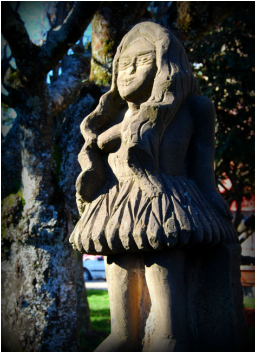Chilote Mythology: The Royal Family of the Sea
By zteve t evans
The Royal Family of the Sea in Chilote Mythology
The people who live in the Chiloé Archipelago of southern Chile have developed their own unique mythology over the centuries which helps to explain their environment and its maintenance. Being islanders they rely upon the sea for much of their sustenance and they have evolved a hierarchy of divine figures who take care of the ocean. This hierarchy is made up of a Royal Family who consist of a king and queen, a prince and two princesses.
The people who live in the Chiloé Archipelago of southern Chile have developed their own unique mythology over the centuries which helps to explain their environment and its maintenance. Being islanders they rely upon the sea for much of their sustenance and they have evolved a hierarchy of divine figures who take care of the ocean. This hierarchy is made up of a Royal Family who consist of a king and queen, a prince and two princesses.
The Millalobo
Millalobo is the king of the seas and was said to have been born from a union by a beautiful woman with a sea lion during the epic battle between Tenten Vilu and Caicai Vilu that created the Chiloé Archipelago.
He had a human wife, Huenchula and they had a son, the Pincoy, the prince of the sea, and two daughters, the Sirena Chilota who was a type of mermaid and the Pincoya a sea nymph. The prince and the princesses helped their father and mother take care of the sea.
Huenchula
As Queen of the Sea, Huenchula would manifest to the islanders through the sound of the waves. In many respects she ensures the sustainability of the ability of the ocean to provide for the people. Huenchula takes an active interest in the ecology and sustainability of the ocean as a resource for humans and will punish those who over fish or misuse it. She had strict rules on how the islanders should harvest shellfish:
Millalobo is the king of the seas and was said to have been born from a union by a beautiful woman with a sea lion during the epic battle between Tenten Vilu and Caicai Vilu that created the Chiloé Archipelago.
He had a human wife, Huenchula and they had a son, the Pincoy, the prince of the sea, and two daughters, the Sirena Chilota who was a type of mermaid and the Pincoya a sea nymph. The prince and the princesses helped their father and mother take care of the sea.
Huenchula
As Queen of the Sea, Huenchula would manifest to the islanders through the sound of the waves. In many respects she ensures the sustainability of the ability of the ocean to provide for the people. Huenchula takes an active interest in the ecology and sustainability of the ocean as a resource for humans and will punish those who over fish or misuse it. She had strict rules on how the islanders should harvest shellfish:
- They must be picked by hand.
- People must not fight or argue over them.
- No wheelbarrows or trucks should be used.
- People should use no more than they need.
 Estatua de la Pincoya by Paul Lowry - Flickr: La Pincoya - CC BY 2.0
Estatua de la Pincoya by Paul Lowry - Flickr: La Pincoya - CC BY 2.0
La Pincoya
In Chilote mythology La Pincoya was a female water spirit or nymph. She was believed to be incomparably beautiful with long blond hair and a naturally sensuous and cheerful disposition. One of the children of the King and Queen of the Sea she would materialize out of the depths of the ocean naked. She would appear before the people naked and pure and perform a ritual dance as her husband, the Pincoy sang. The way she danced would tell the people what kind of harvest they could expect from the sea.
If she danced with her back to the sea and facing the mountains then fish and seafood would be in short supply. When she danced with her back to the mountain and facing the sea the harvest of fish and seafood would be plentiful. The Pincoya is regarded as a beneficial spirit for humanity.
As daughter to Millalobo and Huenchula she was also a princess. She helped take care of the sea along with her brother the Pincoy, who was also her husband and the Sirena Chilota, her sister. One of the tasks of these three siblings was to find the souls of those drowned at sea and take them to a mythical ship called El Caleuche. Once on board they would return to life as crew of the ship.
The Pincoy, Prince of the Sea
The Pincoy was the son of the Millalobo and Huenchula. He was a water spirit similar to a merman. His lower body was similar to a large seal and gold of color. He had a handsome and. masculine face and had long golden hair. Women were magically attracted to him but he was married to the Pincoya, his sister. With his sisters he takes the souls of those drowned at sea to the ghost ship El Caleuche.
The Pincoy also sings a strange and beautiful song which his wife and sister, the Pincoya dances to. The way she dances reveals to the islanders how abundant fish and seafood will be.
La Sirena Chilota
La Sirena Chilota is a kind of fusion between Mapuche mythology and European folk tradition. She is similar in appearance to a mermaid. Her lower body is that of a fish and covered in beautiful, gleaming, golden scales. Her upper body is that of a beautiful young woman and she has long golden hair. As well as helping her brother and sister take those drowned at sea to El Caleuche she has all the fish in the ocean in her care
A Sustainable Future
The Royal Family preserve the sea for the Chilote people helping to ensure their survival and providing a sustainable future for generations of islanders to come.
© 18/10/2015 zteve t evans
In Chilote mythology La Pincoya was a female water spirit or nymph. She was believed to be incomparably beautiful with long blond hair and a naturally sensuous and cheerful disposition. One of the children of the King and Queen of the Sea she would materialize out of the depths of the ocean naked. She would appear before the people naked and pure and perform a ritual dance as her husband, the Pincoy sang. The way she danced would tell the people what kind of harvest they could expect from the sea.
If she danced with her back to the sea and facing the mountains then fish and seafood would be in short supply. When she danced with her back to the mountain and facing the sea the harvest of fish and seafood would be plentiful. The Pincoya is regarded as a beneficial spirit for humanity.
As daughter to Millalobo and Huenchula she was also a princess. She helped take care of the sea along with her brother the Pincoy, who was also her husband and the Sirena Chilota, her sister. One of the tasks of these three siblings was to find the souls of those drowned at sea and take them to a mythical ship called El Caleuche. Once on board they would return to life as crew of the ship.
The Pincoy, Prince of the Sea
The Pincoy was the son of the Millalobo and Huenchula. He was a water spirit similar to a merman. His lower body was similar to a large seal and gold of color. He had a handsome and. masculine face and had long golden hair. Women were magically attracted to him but he was married to the Pincoya, his sister. With his sisters he takes the souls of those drowned at sea to the ghost ship El Caleuche.
The Pincoy also sings a strange and beautiful song which his wife and sister, the Pincoya dances to. The way she dances reveals to the islanders how abundant fish and seafood will be.
La Sirena Chilota
La Sirena Chilota is a kind of fusion between Mapuche mythology and European folk tradition. She is similar in appearance to a mermaid. Her lower body is that of a fish and covered in beautiful, gleaming, golden scales. Her upper body is that of a beautiful young woman and she has long golden hair. As well as helping her brother and sister take those drowned at sea to El Caleuche she has all the fish in the ocean in her care
A Sustainable Future
The Royal Family preserve the sea for the Chilote people helping to ensure their survival and providing a sustainable future for generations of islanders to come.
© 18/10/2015 zteve t evans
References and Attributions
- Copyright 18th October 2015 zteve t evans
- Chilote mythology - Wikipedia, the free encyclopedia
- Rich Myths Lie Beneath the Surface of Chilean Isle - latimes myths | PINCOYA - WIX.com
- Myth and Magic Infuse Chilean Island : NPR
- Estatua de la Pincoya by Paul Lowry - Flickr: La Pincoya - CC BY 2.0
- Pixabay - ClkerFreeVectorImages - CC0 Public Domain

